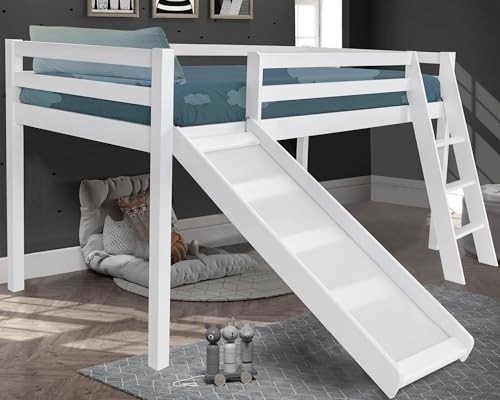10 Things You Learned In Kindergarden That'll Help You With Bunk Bed
A Comprehensive Guide to Children's Bunk Beds: Styles, Benefits, and Safety Considerations
Bunk beds have become a popular choice for households looking to make the most of space and provide an enjoyable sleeping environment for children. With their distinct style, they use a creative and practical option for shared bedrooms, playrooms, and even guest lodging. This post explores the numerous styles of children's bunk beds, their benefits, safety considerations, and responds to some often asked questions.
The Allure of Bunk Beds
Kid's bunk beds are more than just space-saving structures; they are also an entrance to adventurous dreams and creative play. Below is an in-depth evaluation of their numerous benefits.
Advantages of Bunk Beds
- Space-Saving: Bunk beds efficiently use vertical space, making them an ideal choice for smaller rooms.
- Lively Design: Many bunk bed styles include slides, camping tents, and themed aspects, stimulating imagination and enjoyment.
- Partner Sharing: Bunk beds are best for siblings sharing a room or accommodating slumber parties.
- Versatile Use: Some designs can be separated into 2 individual beds, offering versatility as kids grow.
- Storage Options: Many bunk beds feature integrated drawer storage or shelves, further boosting their usefulness.
Styles of Children's Bunk Beds
The range of bunk beds available today deals with various preferences and needs. Below is an overview of some popular designs.
Design
Description
Best For
Requirement Bunk Bed
A standard style featuring one bed stacked above another.
Brother or sisters sharing a space.
Loft Bed
Comparable to a bunk bed without the bottom bunk, enables for a workspace or play area listed below.
Minimal space for play/desk.
L-Shaped Bunk Bed
2 beds set up in an L-shape, typically with additional areas for storage or play.
Special room layouts.
Twin Over Full
A twin bed over a full bed, accommodating different sleep requirements.
Growing kids and teens.
High Sleeper
Stands even higher than a loft bed, generally including a desk or play location below.
Older kids needing more play/desk space.
Tent Bunk Bed
Bunk beds with a canopy or tent-like structure, developing a comfortable, fun space.
Active and imaginative kids.
Secret Features to Consider
When selecting the ideal bunk bed for children, the following functions are worth thinking about:
- Material: Bunk beds can be made from wood, metal, or a mix. Each has its special aesthetic and resilience.
- Weight Capacity: Always confirm the weight limit of the bunk bed to ensure it can accommodate your children safely.
- Security Rails: Ensure the leading bunk has durable rails to avoid falls.
- Ladder Security: A well-designed ladder must provide easy and safe access to the upper bunk.
- Finishing: Ensure any surfaces are non-toxic and safe for kids.
Safety Considerations
Security is paramount when it concerns children's bunk beds. The following guidelines ought to be complied with:
- Age Appropriateness: Generally, children under 6 years of ages should not sleep in the upper bunk due to security threats.
- Tough Construction: Ensure the frame and materials are solid and can support the weight without drooping.
- Regular Maintenance: Periodically look for loose screws, bolts, or other components that may require tightening.
- Clear Play Area: Keep the area around the bunk bed totally free of toys and barriers to lessen tripping dangers.
Setting Rules for Safe Use
Establishing guidelines for bunk bed use will help ensure security:
- Limit Jumping and Climbing: Children ought to be encouraged against jumping from the leading bunk and getting on the sides.
- Supervising Sleepovers: Monitor young visitors while they are utilizing the bunk bed for the very first time.
- Inform on Ladder Use: Teach how to utilize the ladder safely, highlighting the value of dealing with the ladder when climbing or down.
Frequently Asked Questions
1. What age is proper for a child to sleep in the leading bunk?
A lot of makers suggest that children ought to be at least 6 years old to oversleep the upper bunk. This standard is designed to alleviate the danger of falls.
2. Can bunk beds be customized?
Yes, lots of makers offer personalized alternatives, including colors, materials, and extra features like drawers or desks.
3. Are bunk beds safe for weight?
Bunk beds have weight limitations, normally ranging from 200 to 400 pounds, depending on the model and product. Constantly examine the manufacturer's specifications.
4. How do I keep and clean a bunk bed?
Routinely examine for loose parts, keep the bed clean by cleaning down surfaces, and make sure the bedding is fresh to promote a safe and sanitary sleep environment.
5. Can bunk beds be separated into specific beds?
Numerous bunk beds feature an alternative to separate them into two specific beds, providing long-term versatility.
Kid's bunk beds are more than simple furniture; they are a practical, versatile, and imaginative element of a child's space. With different designs offered and numerous security factors to consider to keep in mind, parents can pick the best bed that fits their space, fulfills their kids's needs, and instills a sense of experience. By understanding the advantages, styles, and precaution connected with bunk beds, families can develop a delightful and protected sleeping environment for their kids. Whether for Kary Schiesser or sisters sharing a room or space-saving services, bunk beds remain a cherished option for many households.
